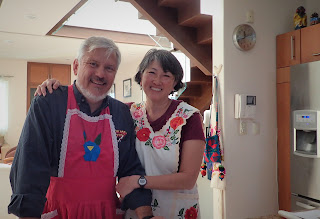Mezcal Tour, Oaxaca State, Mexico

The people of Oaxaca are very proud of their traditions, many of which are unique within Mexico. Mole (there are 7 kinds), and mezcal are two of the better-known ones. We decided to take a full day tour of several palenques (the places where they make mezcal) with a local expert, a gringo who has lived in Oaxaca for a long time and devoted his “retirement” to spreading the mezcal gospel.
About Mezcal:
Mezcal is made in 9 specific regions of Mexico: Oaxaca,
Durango, Guanajuato, Guerrero, San Luis Potosi, Tamaulipas, Zacatecas,
Michoacan, and Puebla. Oaxaca is the center of the mezcal world, responsible
for 85% of all mezcals.
 First,
a quick description. Mezcal is a distilled spirit made from a wide possible
array of agaves. The predominant variety of agave used is espadín, in part because of its shorter growing period (~8
years vs. 15 years) and its higher carbohydrate
content, so it takes 12-15 kg (~30 lbs) of espadín hearts to make 1 liter of mezcal, compared to maybe 30 kg (~60
lbs) of variety tobalá.
First,
a quick description. Mezcal is a distilled spirit made from a wide possible
array of agaves. The predominant variety of agave used is espadín, in part because of its shorter growing period (~8
years vs. 15 years) and its higher carbohydrate
content, so it takes 12-15 kg (~30 lbs) of espadín hearts to make 1 liter of mezcal, compared to maybe 30 kg (~60
lbs) of variety tobalá. |
| Long day of tasting...just starting! |
Our tour:
 |
| Horno earth oven |
 |
| piñas, machete shown for scale |
 |
| horse working a tahona |
 |
| Our tasting begins...yes, gas cans |
We had no idea there
were so many…and they propagate 3 different ways. #1: via a sprout coming from
the roots of an existing plant, called a hijuelo
(little son). These hijuelos are
clones of the mother plant, so do not add to genetic diversity. This is how
most agave tequiliana plants are
developed, which puts tequila in the crosshairs of being a serious monoculture.
 |
| method #3 |
#3: the stalk will eventually have small sprouts
that can be cut from the stalk and planted.
Generally, the stalk is
not allowed to grow since it uses a lot of plant energy, resulting in less
convertible starches in the piña.
 |
| Chicken breasts used in pechuga |
Sales & Marketing
An interesting
difference with mezcal (and tequila) versus something like bourbon is that the
time to market may be similar – ~7 years– but the reason is inverted. For
mezcal, you are waiting for the plant to mature, whereas with bourbon, the
inputs are readily available at any time but the aging process after
distillation causes the wait.
Mezcal sales growth
rate, ~40%, each of the past 6 or so years has led all distilled spirits –
albeit starting from a small base. This demand has pushed prices for piña from maybe 400 pesos per tonne 10-12 years ago to 15,000 pesos, or
more. It has also made theft a problem for growing areas. Our guide mentioned
having 250 plants stolen in one night. Imagine the loss if you are a small
farmer who has been waiting 7 years for a harvest, only to have it stolen!
 |
| mucho mezcal |
If you are in Oaxaca and want to seriously taste mezcal...Alvin Starkman can be found at: https://www.mezcaleducationaltours.com/
(24 noviembre 2018)













































